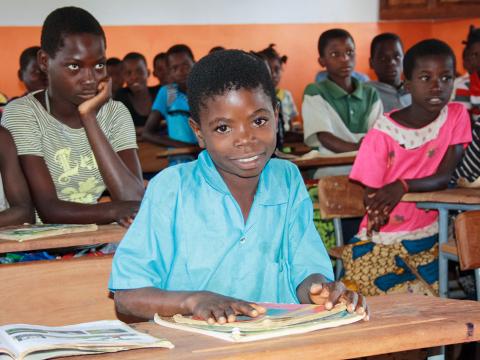Children begin to dream in new school

A conventional new school constructed by the community and World Vision is providing a suitable environment for studying and awakening the dreams of children.
Studying in Nihessiue Primary School, in northern Mozambique, is no longer a synonym with compulsory discomfort. The community and World Vision constructed a new conventional school for the students who seek knowledge every day.
The community led the process and World Vision gave extra support by providing some materials and equipment for the school. The new structure is a suitable environment for studying and awakening the dreams of children for a better future.
“I love my new school because it is beautiful,” says fourth grade student, Dulce Arabito, 10.
“It (school) has got school desks, windows and zinc sheets,” adds the smart girl, comparing the new building with the old school.
However, her joy is also outside of the classroom. A little park where children have the opportunity to play during the breaks and after lessons has also been constructed.
If everything goes as planned, in the future Dulce will find herself in a white uniform taking care of a child in a local health centre, the dream that World Vision is helping to build.
“I want to become a nurse to care of other children and help my parents and my siblings to study,” Dulce says.
The smart girl talks about her old school building as a place that was detrimental to her education.
“My old school was made by straw grass and roofed with plastic and grass. When it rained it used to drop inside,” Dulce recalls. “Sometime when it rained, we could not have lessons.”
Despite the young age, Dulce’s description explains exactly how most schools in the rural Mozambique look like.
Here, having a conventional and equipped school is still a privilege. Adequately equipped schools motivate children to learn and attract more students, according to the teacher Moises Alexandre.
“Everything changed in the school, starting from physical aspect that attracted more pupils to school, especially with the child park. Last year we had 347 pupils and this year 412 and they are still enrolling and this is encouraging us as teachers,” Moises says. “Today, for instance, it is just drizzling but we could not have lessons that time, but now we are ongoing normally,” he adds.
Teachers like Moises are also thrilled with the results.
“You have a child is in a classroom, sitting on the ground and is every time stretching and changing positions of their feet because he is not comfortable, it is impossible to focus on the lessons. But if you provide better conditions, they will fully concentrated on the lesson. This is true in our school.”
Starting point
Dulce lives with her grandparents, two farmers who decided to take care of their step-granddaughter. Her grandfather, António Tocoló, was actively involved in the construction of the school. He shares how it started.
“Within the communities we decided produce the bricks and collect stones for building as theses resource are locally available.” Antonio says. “But we had a challenge to have other materials because we couldn’t afford to buy other material. What we produced is not even enough to feed our families. We decided to go to World Vision to ask for help. It was accepted and the result everybody can see.”
If children are happy with the school, their parents are grateful as they will have more time to dedicate to farming, instead of spending it rebuilding the school.
“Beyond our children studying in better schools, we (parents) are relieved because annually we had to reconstruct the school because it could last for more than a year. This meant that we had to leave our activities in the farms from where we get our food to go to the forest to cut the poles, grass and rebuild the school,” Antonio says.